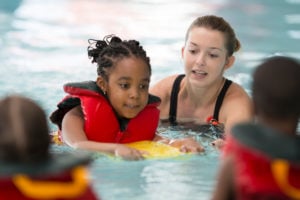
The Lamber Goodnow legal team urges you to watch your kids around water and follow these important ABC’s of pool safety
Although back to school time is right around the corner, in many warmer climates, summer activities are extended, and in Arizona many of those activities revolve around water. Whether it is a private or public swimming pool, Tempe Town Lake, the Salt River, or any of the multiple lakes around our diverse state, it is important for both parents and children to be educated about swimming pool safety and water safety and pool requirements in order to keep summer vacation from turning into a tragedy.
Two new reports from the U.S. Consumer Product Safety Commission (“USCPSC”) cited that 390 children drown each year in the United States, with the majority of this number occurring in the summer.[1] Inez Tenenbaum, chairman of the USCPSC, puts that number into perspective explaining, “We are talking about 15 preschool classes lost in a pool or spa every year.”[2]
In 2016 in Arizona alone, there have been 104 water related incidents and 33 water related deaths. Nine have been children between the ages of 0-5, one has been a teenager (13-17 years old) and 23 have been adults (18 years and above).[3] Additionally, drowning is the leading cause of death in 1-4 year olds in Arizona.[4]
Some of the common causes of drowning include:
- No barriers around the pool
- Lack of swimming ability
- Lack of supervision in the bathtub or any body of water
- Alcohol use
- Failure to wear life jackets
- Panic in the water
- Concussion, seizure or heart attack while in the water
- Boating accidents
- Fatigue
- Not appreciating the environment, including diving into shallow water or walking on thin ice.[5]
Lori Schmidt, president of the Drowning Prevention Coalition of Arizona, says the ABCs of preventing drowning remain the first and best line of defense when working at eliminating child and adult fatal drowning incidents. Schmidt explains, “The No. 1 thing people need to understand is we can prevent drowning so we need to make sure we take those steps to lower our chances. Drowning prevention is a three-pronged approach with the key being adult supervision.”[6] The three prongs include: adult supervision, barriers to water access and CPR classes for adults.[7]
Other ways to prevent drowning include:
- Educating your child about pool safety, including, but not limited to, where they can swim, what activities are appropriate, if they may dive into the pool, what to do if they are struggling in any way, where the pool ladders or steps are located and what to do if another child is struggling in the pool
- Teaching your child what drowning means
- Always having a pool barrier, it is not enough to just lock the house doors, children of all ages can think of crafty ways to open a locked door, go through a window or out a doggy door
- Parents must educate themselves, including CPR, proper supervision, and correct installation of pool drains and covers
- Appreciating and knowing the environment, including water depth, water current and terrain
- Enrolling your child in swimming lessons, children are able to begin swimming as young as six months of age.[8]
- Never consuming alcohol while operating a boat or any type of watercraft
The Arizona State Legislature has recognized the importance of pool safety and passed A.R.S. § 36-1681 to prevent children from gaining unsupervised access to residential swimming pools. The statute includes requirements such as: pool enclosure height (must be at least five feet high), door and gate measurements, when a wall or barrier is necessary and enclosure distance from the water’s edge.[9]
As Schmidt explained, we can prevent pool drownings, and with the proper actions and education, when your children wake up on the last day of summer begging you for yet another family pool day, you can throw on your suit, fire up the BBQ and make memories you will never forget.
[1] Silvia Rodriguez, abc15, 390 kids drown in US pools each year, report finds, (May 23, 2013), www.abc15.com/news/national/390-kids-drown-in-us-pools-each-year-reports-find).
[2] Id.
[3] Children’s Safety Zone, Water Safety, (Jul. 26, 2016), http://www.childrensafetyzone.com/go/water-related-incident-reports/maricopa-and-pinal-counties-valley-of-the-sun/.
[4] Id.
[5] emedicinehealth, Drowning Prevention, (Medically reviewed by a doctor on Jun. 26, 2015), http://www.emedicinehealth.com/drowning/article_em.htm.
[6] Terrance Thornton, Scottsdale Independent, Officials: Fatal drownings continue year after year in Arizona, (Jun. 17, 2015), http://www.scottsdaleindependent.com/news/officials-fatal-drownings-continue-year-after-year-in-arizona/.
[7] Id.
[8] Id.
